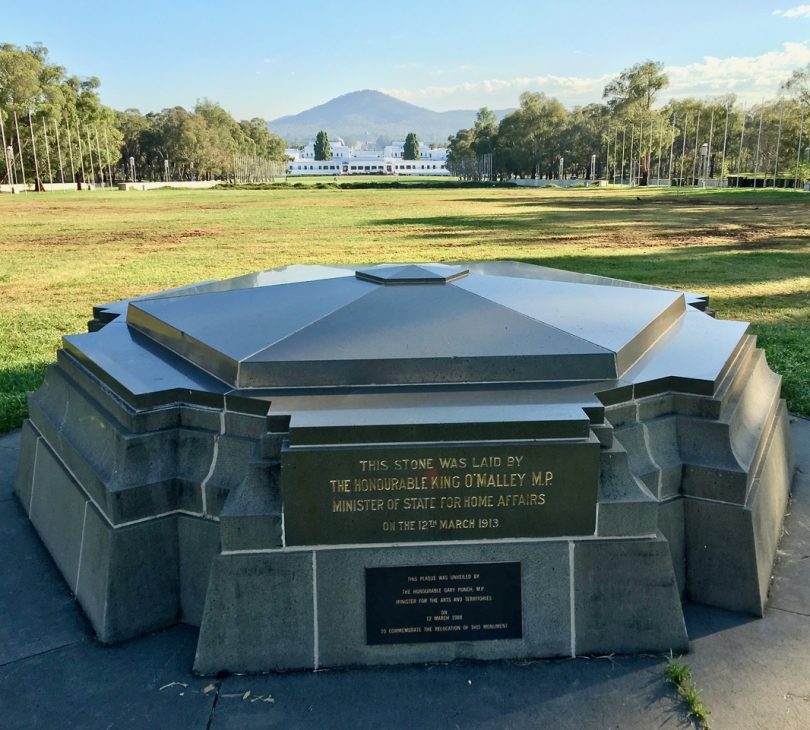
Canberra’s foundation stone, which was laid on 12 March, 1913. Photo: Marg Wade.
March in Canberra is a wonderful time of year. Balmy days, cool nights and so much to do, especially witnessing the vibrant illuminations of the Enlighten Festival, and the colourful balloons soaring overhead as part of the Canberra Balloon Spectacular.
The date of Wednesday, 12 March, 1913, was also a time for celebration in the region, and a significant moment in Australia’s history. This was the day the new federal capital got its name.
Since Australia’s federation in 1901, and the decision to locate the federal capital on the Limestone Plains, anticipation had been rising about what the new city’s name would be. Until then, it was simply referred to as ‘the federal capital’.
Many names were suggested such as ‘Eucalypta’, ‘Olympus’, ‘Cookaburra’, ‘Austral’, ‘Shakespeare’ and ‘Myola’. Other suggestions included ‘Wheatwoolgold’, ‘Kangaremu’, ‘Eros’, and ‘Thirstyville’. ‘Sydmeladperbrisho’ was one of the sillier suggestions, an amalgam of all the state’s capital city names.
The day of 12 March, 1913, dawned clear and sunny. Previous days had organisers worried. Torrential rain and bitterly cold winds had led to conjecture that a good name for the new capital might be ‘Antarctica’.
A granite structure was at the centre of attention. This, the federal capital’s foundation stone, located on Kurrajong Hill, was designed by chief government architect John Smith Murdoch, who had also designed several of the capital’s early buildings, including Old Parliament House, Kurrajong Hotel, the Powerhouse (now Canberra Glassworks) and Hotel Canberra.
Designed in six sections to represent the six colonies before federation, the foundation stone was also intended to include an eight-metre obelisk with four corners – representing the four corners of the Empire. This was never built.
Great excitement heralded a day of pomp and ceremony with 500 invited guests dressed in their finery. More than 700 mounted and artillery troops from the Australian Field Artillery, Light Horse and NSW Lancers marched and displayed their skills.
A crowd of 3000 locals also eagerly awaited the formal naming of the capital city.
Special sleeper trains brought invited guests from Sydney and Melbourne. Travelling overnight, they arrived in Queanbeyan in time for an early breakfast before heading to the ceremony at Kurrajong Hill. The anticipated heavy traffic on the dirt roads – that included Model T Fords, wagons, buggies and bicycles – led to the advisory notice for all ladies to ‘provide themselves with dust coats’ for the journey.
A grandstand was erected near the foundation stone and crowds enthusiastically applauded and cheered as the stone sections were moved with a large winch and cemented into place. Governor-General Lord Thomas Denman, Prime Minister Andrew Fisher, and Minister for Home Affairs King O’Malley each used personally inscribed trowels to officially set the cement and declare the stones laid.
At precisely 12 pm, the moment everyone had been waiting for arrived. The crowd fell silent. All eyes were on Lady Gertrude Denman, wife of the Governor-General who was in an elegant ostrich-plumed hat and pearls, as she stood on the specially made platform over the top of the foundation stone.
With her were Lord Denman, Prime Minister Fisher, and King O’Malley. Lady Denman’s hand slipped into an inscribed gold case, drawing out a card bearing the new capital’s name.
Onlookers held their breath. Lady Denman smiled.
And then it came.
“I name the capital city of Australia, Canberra,” she announced.
The crowd roared, and the Prime Minister led three cheers. A hymn was sung, a 21-gun salute sounded and a cable was dispatched to his Majesty the King. A passing march took place and invited guests proceeded to the luncheon tent.
It was a huge day, indeed.
Today, we can glimpse the exhilaration and excitement of the celebrations of the official naming of Canberra, with film footage that has been restored by the National Film and Sound Archive of Australia, at the National Capital Exhibition at Regatta Point. Copies are also available for sale from the National Film and Sound Archive.
We can find the foundation stone located directly in front of Parliament House on what is now known as Capital Hill. The stone was originally laid close by, but was moved to be in line with Walter Burley Griffin’s land axis in 1988.
A small plaque marks the original location, which is just to the left of the Michael Nelson Tjakamarra mural in the forecourt of Parliament House.











